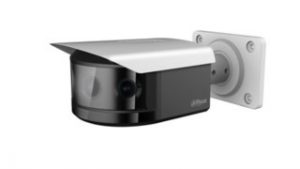
As a systems integrator, what’s the biggest advantage you can provide for your video surveillance customers? Greater situational awareness at all times. Today’s advanced multi-sensor camera technologies deliver a multitude of benefits — not only for the integrators who install the systems but to the end users who operate them.
Here’s a closer look at why everyone stands to profit.
Attractive Cost Savings Ahead
Integrators and end users can surely appreciate the budgetary benefits that deploying multi-sensor surveillance cameras provide. For the customer, a multi-sensor camera can do the job of several cameras. That means fewer cameras to purchase, fewer cameras to have installed, fewer cameras to monitor, fewer cameras to maintain, and fewer recordings to sift through! Additionally, end users will typically need only one VMS license for the multiple sensors rather than having to purchase multiple licenses for separate cameras.
For integrators, pitching products that will yield a lower total cost of ownership over their lifetime is just one of the perks.
You also benefit from savings — on your own installation time having to run less cabling as well as rolling fewer trucks for maintenance work. Meanwhile, another value-add of housing one camera as opposed to numerous units for a particular coverage area is a more aesthetically pleasing, cleaner installation. No more messy clusters of cameras to clutter up a building or corridor.
Fantastic Features Favor Multi-sensors
Wider area coverage, high resolution multi-megapixel images, intelligent analytics at the edge, pan/tilt/zoom (p/t/z) capabilities, H.265 high efficiency video coding, low-light performance, indoor/outdoor usage … there are multiple reasons to relish the comprehensive functionality of today’s state-of-the-art multi-sensor video cameras.
The key advantage of using multi-sensors is the increased overall situational awareness, because they offer a wider field of view — most often 180° and 360° — so operators can easily comprehend and react more quickly to what’s happening in a full scene without having to switch between channels, or be hindered by eye fatigue.
But here’s where the quality of the camera can make even greater impact, because accurate, seamless stitching is the biggest feature integrators should look for.
Would your customers prefer one seamlessly flowing image where no detail goes unnoticed, or a choppy one that looks like three side-by-side images?
Solutions That Fit The Bill
Dahua Technology USA has integrators and end users covered. Along with its 6MP HD Multi-Lens Panoramic Network IR Bullet Camera, the company recently introduced two additional multi-sensor models: the All-in-One that combines eight 2MP sensors and 37x PTZ for a 360° field of view (a 180° version is on the way, too); and the HDCVI 3.0 6MP Panoramic IR Bullet Camera, the industry’s first multi-sensor for coaxial infrastructure.
The auto-tracking and p/t/z abilities of the All-in-One enable operators to effectively utilize one monitor for situational overview boosted by a second monitor for zooming and tracking.
The cameras offer a bit of future-proofing and more potential savings, too, as they include H.265-ready dual codec and simple toggle switch that allows them to move from H.264 when ready — and realize savings in bandwidth and storage.
Multiple Applications Can Take Advantage
Customers in various vertical markets can capitalize on multi-sensor video surveillance cameras. The panoramic view can deliver detailed coverage for wide-open spaces such as sports stadiums and city centers, for instance. Additionally, the embedded IR in Dahua’s multi-sensor cameras enables customers to feel confident about their facilities’ guard against nighttime vulnerabilities. For corridors in educational and hospital facilities — like nurse stations often found at the intersection of hallways — the cameras are ideal because they can capture various angles that ordinarily might require several cameras.
Multi-sensors earn ROI for retail customers especially, considering they can employ the intelligent analytics such as people-counting and heat-mapping to better determine how people shop there and where to place products. Plus, user-defined rules can be set up with the analytics so operators can be more effective and receive automatic alerts to augment their monitoring.











